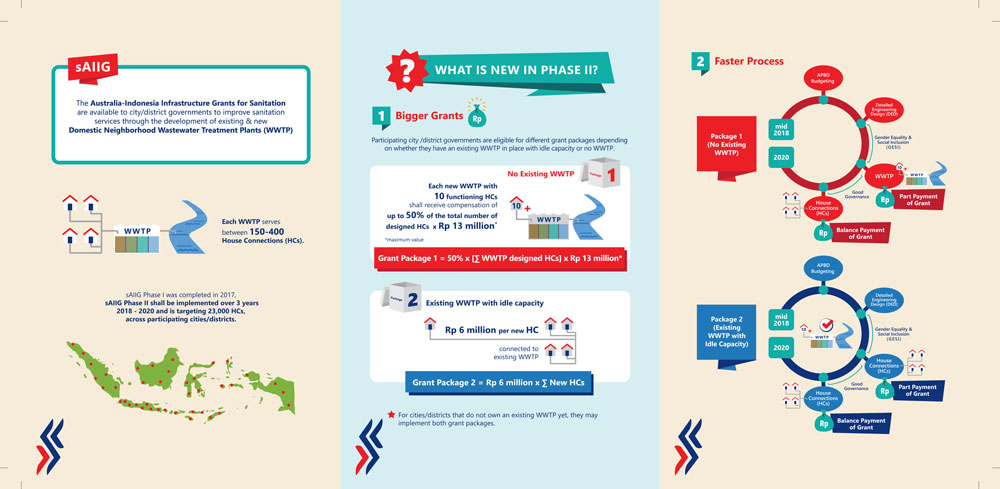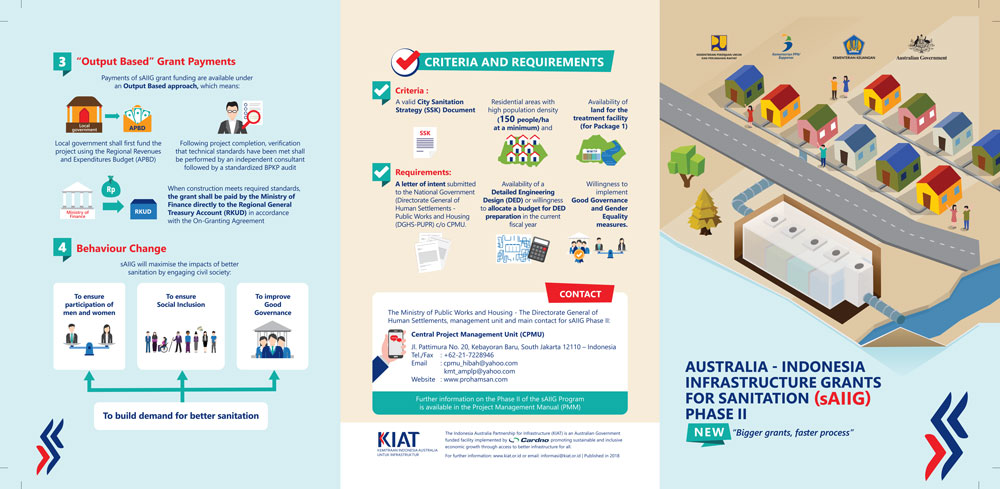Development assistance in Indonesia

The Australia Indonesia Infrastructure Grant for Municipal Sanitation (sAIIG) program, started in 2012 and was designed to improve local government (city/districts) sanitation services through the development of existing and new domestic neighbourhood Wastewater Treatment Plants (WWTP). The first phase was completed in 2017.
sAIIG program Phase II will be implemented over 3 years 2018-2020 targeting an additional 23,000 house connections (HCs) across participating cities/districts.
New features of sAIIG Phase II
- sAIIG Phase II offers bigger grants for city/district governments with no existing Waste Water Treatment Plants (WWTP). Each city/district government which builds a new WWTP will receive reimbursement of up to 50% of the total construction cost. In addition, for the first 10 functioning house connections (HCs) they will be reimbursed up to IDR 13 million per connection and IDR 6 million for each additional HC. City/district governments who have existing WWTP with idle capacity, will be reimbursed IDR 6 million for each new HC.
- sAIIG II also offers a faster reimbursement process:
- Package 1 (No Existing Waste Water Treatment Plant) – from mid-2018 interested cities/districts can submit APBD budget, Detailed Engineering Design and GESI-CSE documents for a tender process which will be followed by WWTP construction. The first grant payment is then made. Following program socialization involving communities and local government, house connection construction commences. Once verified and technical standards are met, a second grant payment is made.
- Package 2 (Existing WWTP with idle capacity) – Similar requirements to Package I, with documents and construction only for house connections.
Output-based Grant Payments
Payment of sAIIG grant funding is available under an output based approach, which means:
- Local government will first fund the project using Regional Revenue and Expenditure Budget (Anggaran Pendapatan dan Belanja Daerah - APBD)
- Following project completion, an independent consultant followed by a standardized BPKP audit will verify that the project meets required technical standards.
- Finally, the Ministry of Finance (MoF) pays directly to the Regional General Treasury Account (RKUD) in accordance with the On-Granting Agreement
Behaviour Change Approach
In order to build demand for better sanitation, sAIIG will maximise the impacts of better sanitation by engaging civil society to ensure: (i) participation of men and women; (ii) social inclusion to include marginalized group; and (iii) improved governance by the participating city/district.
sAIIG Criteria and Requirements
The criteria for the participating city/districts are as follow:
- Valid City Sanitation Strategy (SSK) document;
- Residential areas with high population density at least of 150 people/hectare; and
- Availability of land for building the waste water treatment facility.
The participating city/districts are required to:
- Submit a letter of intent to the Central Project Management Unit (CPMU), Directorate General of Human Settlement, Ministry of Public Works and Housing;
- Have a Detailed Engineering Design (DED) or willingness to allocate a budget for DED preparation in the current fiscal year in their the Regional Revenue and Expenditure Budget (Anggaran Pendapatan dan Belanja Daerah - APBD); and
- Be willing to implement Good Governance and Gender Equality measures within the program.
Further information on sAIIG Phase II is available in the Project Management Manual (PMM) at www.prohamsan.com


